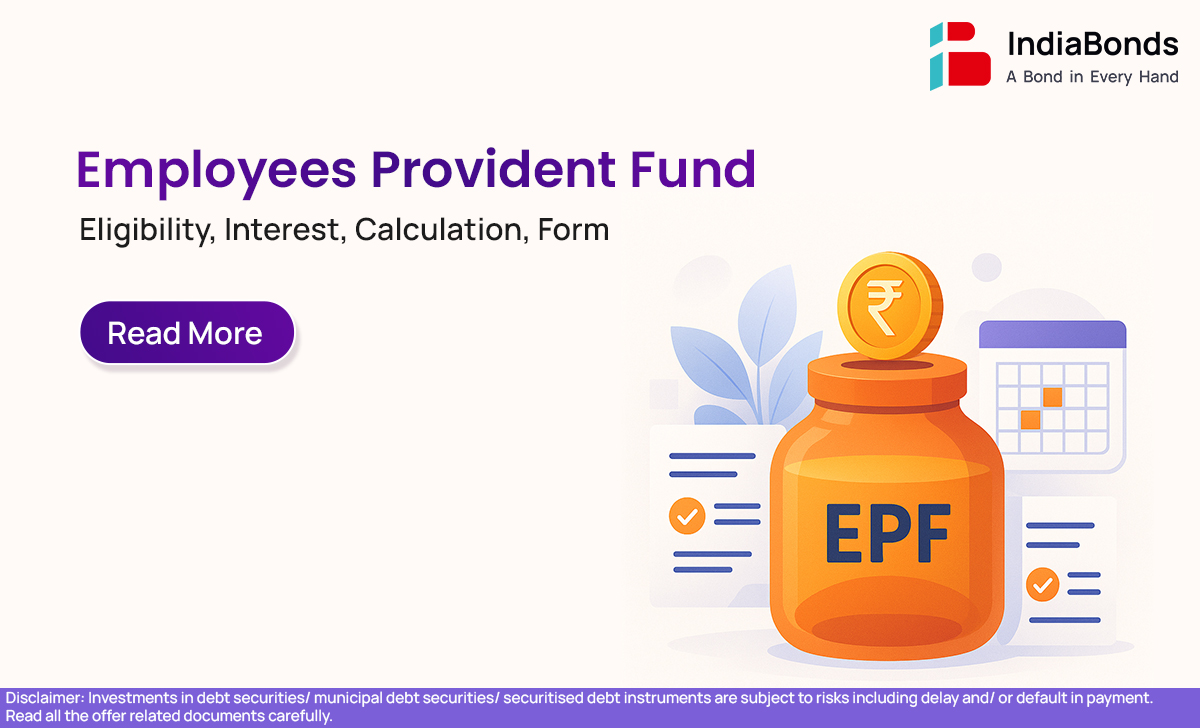Employees Provident Fund (EPF) – Eligibility, Interest, Calculation, Form

Introduction
If you’ve ever looked at your salary slip and wondered, “Wait, why is my take-home less than my CTC?” — chances are, a part of it went into your Employees’ Provident Fund (EPF).
Think of EPF as a money jar you’re not allowed to open right now. You put some money in every month, your employer matches it, and the government watches over it until you really need it — like retirement or certain emergencies. It’s like your future self is sending you a thank-you note in advance.
EPFO – Employees’ Provident Fund Organization
Behind EPF is the Employees’ Provident Fund Organization (EPFO). They’re like the caretaker of all this money. Under the Ministry of Labour and Employment, EPFO collects your contributions, adds interest, keeps track of your balance, and makes sure you get your money back when the time comes.
Schemes Offered Under EPFO
EPFO isn’t just about EPF. It also runs:
- Employees’ Provident Fund Scheme (EPF) – Your retirement savings.
- Employees’ Pension Scheme (EPS) – Pension after retirement.
- Employees’ Deposit Linked Insurance Scheme (EDLI) – Life cover for employees.
It’s like a combo pack — savings, pension, and insurance in one.
Objectives of EPFO
At its heart, EPFO wants you to:
- Save regularly without depending on willpower.
- Have some backup in case of emergencies or job loss.
- Ensure your family gets support if something happens to you.
In short — less stress about money later.
UAN and EPFO Portal
If EPF is your account, UAN (Universal Account Number) is your ID card. This number stays the same no matter how many jobs you switch. The EPFO portal lets you:
- Check your balance in minutes.
- Download your passbook (like your PF diary).
- Transfer your money when you change jobs.
- Update your details.
No more running to HR for every small thing.
EPF Eligibility
You’re covered under EPF if:
- You work in a company with 20+ employees.
- You earn up to ₹15,000 in basic salary (it’s mandatory).
- Even if you earn more, you can opt in with your employer’s agreement.
So yes, EPF isn’t only for those earning under a certain limit — it’s for anyone whose company agrees.
EPF Interest
The fun part? Your EPF balance earns interest. For 2023–24, it’s 8.25% per annum. This isn’t like a bank FD where you see the interest every quarter. Here, it’s calculated every month but credited to your account once a year — like a big annual bonus.
How is Interest on EPF Calculated?
Let’s say your balance on April 1 is ₹1,00,000 and the annual interest rate is 8.25%. Your interest in April would be:
₹1,00,000 × 8.25% ÷ 12 = ₹687.50.
This happens every month, adding to your balance, and at the end of the year, the total interest is credited in one go.
EPF Calculation
Here’s the math in simple words:
- You contribute 12% of your basic salary + dearness allowance.
- Your employer also contributes 12% — but splits it into EPF and EPS (pension).
Example: If your basic salary is ₹20,000:
- You put ₹2,400 into EPF.
- Employer puts ₹733 into EPF + ₹1,667 into EPS.
So your PF isn’t just your money — it’s double boosted.
EPF Form
Different forms for different needs:
- Form 19 – Full withdrawal.
- Form 10C – Pension-related withdrawal.
- Form 31 – Partial withdrawal for things like medical needs or education.
How to Transfer EPF Money
Changed jobs? No need to start over. Just log in to the EPFO portal with your UAN, request a transfer, and get it approved by your old and new employers. Done.
EPF Benefits
- Retirement fund for peace of mind.
- Tax benefits under Section 80C.
- Loans/advances in tough times.
- Pension through EPS.
- Life cover under EDLI.
It’s like a safety net you didn’t have to set up yourself.
EPF Withdrawal Rules
You can take out your EPF:
- On retirement.
- After two months of unemployment.
- Partially for marriage, education, home loan repayment, or medical needs.
EPF Taxation
- Withdraw after 5 years of continuous service = tax-free.
- Withdraw earlier = taxable + TDS may apply.
Withdrawal Process of EPF
- Log in to EPFO portal.
- Select claim option.
- Enter bank details and reason.
- Verify with Aadhaar OTP.
That’s it. No long queues like the old days.
EPFO Information for Grievance
Facing issues? EPFO’s online grievance system lets you file complaints for delays, transfer problems, or account corrections.
Conclusion
EPF might seem boring when you’re young, but it’s one of the smartest ways to build long-term wealth without thinking about it every month. It’s money you’ll thank yourself for later — with interest.
FAQs
1. How will EPF interest be calculated?
It’s calculated monthly on your balance at the declared annual rate and credited yearly.
2. Who is eligible for PF interest?
Anyone with a balance in their EPF account, even if no new money is coming in (for up to 36 months after leaving the job).
3. How is PF eligibility calculated?
You’re eligible if you work in a covered company, earn up to ₹15,000 in basic pay (mandatory) or opt in voluntarily.
4. Do we get interested on a PF calculator?
The calculator just estimates based on your input. The real interest is credited by EPFO.
Disclaimer : Investments in debt securities/ municipal debt securities/ securitised debt instruments are subject to risks including delay and/ or default in payment. Read all the offer related documents carefully.
































